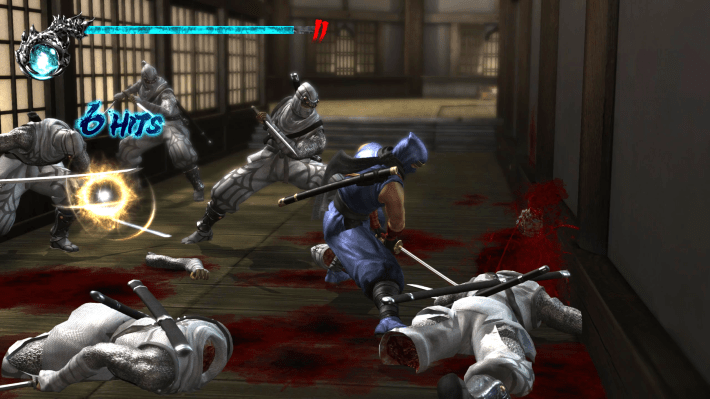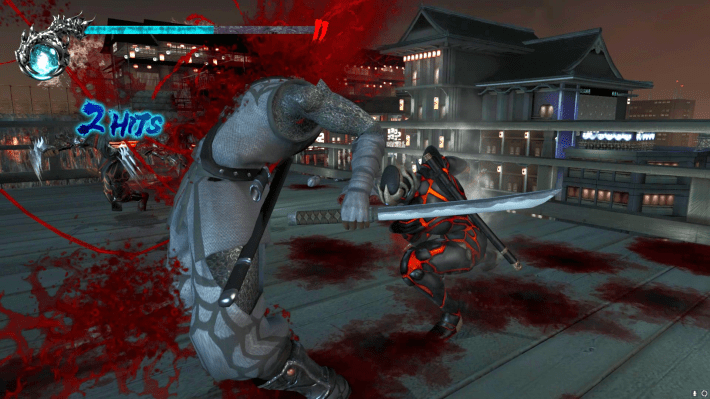Ninja Gaiden for Xbox is one of the greatest games ever made. When it came out in 2004 it was a jaw-dropping HD showpiece for the console. Mechanically, it is a work of art that turned basic actions in a space into a ballet of violence. Few games since have felt as good, and one of the few that does was the follow-up Ninja Gaiden II for the Xbox 360. Of course, II was not initially perfect: the game was badly optimized, brutally difficult, unbalanced and about a third too long. As a result it was not received as well as the first game. So when it came time to port Ninja Gaiden II to other platforms like the PS3 with Ninja Gaiden Sigma 2, Team Ninja radically changed the game. That is the version you can buy on Steam, and a lot of diehard fans dislike it. One modder has spent years building modding tools to right the wrongs of Ninja Gaiden Sigma 2.
Ninja Gaiden II features many radical changes from its predecessor. Both games are unforgiving character action games, but Ninja Gaiden II introduced several key mechanics that changed the way it is supposed to be played, starting with delimbing. Foes in the game can have limbs severed but still fight. A delimbed foe is easy to finish with a move called an Obliteration Technique. Delimbed foes can also be tactically spaced, but those foes are prone to far riskier moves, oftentimes throwing themselves at you in explosive, self-destructive attacks. Furthermore, the overall balance of the game shifted between I and II. Ninja Gaiden is a more defensive game, one that rewards cautious action, while Ninja Gaiden II is far more aggressive, rewarding a player who presses their advantage. What’s more, Ninja Gaiden II downright throws enemies at you, often too many for the Xbox 360 to handle.
This poor performance is no longer an issue thanks to emulation and backwards compatibility. The original version of Ninja Gaiden II will run like butter on a Series X thanks to the fantastic job Microsoft did with backwards compatibility (you can still purchase and download it here, as well as the best version of the first game, Ninja Gaiden Black), but that version is exclusively limited to the Xbox ecosystem.

The re-release of Ninja Gaiden II, dubbed Ninja Gaiden Sigma 2, is a very different situation. It was first introduced on the PS3, and so many changes were made to compensate that they threw the baby out with the bathwater. Mission structure was retooled and optimized, and one very mediocre boss was replaced. The lighting was tweaked. Several bosses were added, like a big Buddha statue and The Statue of Liberty. These fights are mindless and awful, and both bosses devolve into the player slashing at their hands until they die. New weapons and side missions with other characters were added; these side characters have very interesting movesets, but the missions themselves add nothing to the overall experience. The worst change, however, is that Sigma 2 radically reduces the number of enemies on the screen and makes them far less aggressive. The rate at which your weapons delimb enemies is also radically reduced, completely altering weapon balance and flow. Instead of managing a swarm of murderous foes, you are instead dealing with a few somewhat spongey enemies. For all of Ninja Gaiden II’s flaws, and there are many, that is seen by many hardcore fans (but not all) as an unforgivable slight.
Undoing the damage.
Ninja Gaiden Sigma 2 Black is an in-development overhaul of the Ninja Gaiden: Master Collection version of Ninja Gaiden Sigma 2 by modder Fiend Busa. It’s an attempt to undo the changes done in the remastering process in the most readily available version of the game.
Prior to the mod, Fiend Busa had no substantial history with modding. “As soon as [Ninja Gaiden: Master Collection] was released for PC - I was learning as I was going the entire way,” he told me via Discord.
Busa has been working on it for more than three years, dissecting the code daily trying to figure out how it works and teaching himself Assembly in the process. For a while the mod ran on Cheat Engine, but as of the last month that is no longer the case, and the newest version of the mod is in Alpha. It adds back respawns previously removed, and makes many under the hood tweaks. As of this writing, the current version of the mod is only playtested on the ultra hard Master Ninja difficulty, but in the coming weeks it will be ported to other difficulties in the game.

“In terms of feel, the big one is micro stuttering,” Busa said when I asked about the changes between the vanilla and Sigma versions of the game “In Sigma 2, when you perform certain actions such as Izuna drop, OT, delimb an enemy, the game purposely freezes the frame (I assume this was to give added "oomph"). There are some slight differences in attacks but I won't get into that too much as most casual players will not notice it.”
“The other complaint I hear a lot is regarding AI aggression, where NG2 enemies are more aggressive than NGS2. For [the] majority of the enemies they behave exactly the same and the difference comes in grab speeds, if enemies can grab you on block etc. There are changes to attack properties and such, but these changes only the pro players will notice them (and can be modified pretty easily).”
“The third biggest one is delimb,” he said. “Each enemy is essentially assigned a ‘delimb resistance value.’ What it seems like they did in Sigma 2 was for certain enemies they basically upped the delimb resistance by 50% (i.e., [Incendiary Shuriken] Ninja) and then Sigma 2 decided to also add additional properties to certain moves that would bypass the resistance so even if you set the delimbs to very high certain moves such as (scythe wall throw) would ignore it.”
I asked how he was getting the mod to run as close to the original game as possible. “Most [of] the stuff in Sigma 2 [is] just ‘disabled’ so the majority of it is debugging and ‘enabling.’ Certain stuff is a bit more complex as it's not 1:1 so I would end up hooking into multiple functions to get it working exactly how I want and as close to NG2 as possible.”
For the spawns, Fiend Busa wrote his own custom spawn system and simply played the original game in the 360 emulator Xenia. “I essentially just run through Xenia to note down the amount of enemies spawning per battle, enemy type, and deleted battles and punch those into my spawn system.” In some cases, like in the area around the Buddha statue fight, Busa added enemies to make the game harder than it originally was.

Busa sees possibilities outside of simply returning Ninja Gaiden Sigma 2 to its original state. Down the line, he wants to make the additional content an on/off toggle, and he believes that the spawn system could be used to add custom difficulties to the game, potentially adding fiend variants of the side characters as enemies.
Enter the Ninja

While writing this article, the only difficulty in Ninja Gaiden Sigma 2 Black with the spawns fully enabled was the ultra hard “Master Ninja” mode. Unlocking this mode requires beating the game on the hard difficulty, called “Mentor,” so I decided to make a go of that on the original Ninja Gaiden Sigma 2. It was a cake walk. Enemies were easy to space and slightly tedious, save for an occasional one hit insta-kill that would come out of nowhere. I got 60 percent of the way through the game on Mentor before Busa just gave me his save file. I loaded it up (noting the timer had been maxed out), started a new Master Ninja save, and immediately got my shit rocked. The game had become merciless.
“The core gameplay seems to reward aggressive playstyle as the more aggressive you are, enemies will back down,” Busa explained. “Next time you hop in, if you see an enemy coming your way from afar, just lightly tap an enemy close by and you'll see it'll back off (most of the time).”
With Ninja Gaiden Sigma 2 Black enabled, all of the systems immediately complemented each other better. The flow of combat was faster, room for error was shaved down to mere frames, and even when I knew exactly what to do I never felt complacent. More foes meant more possibilities to account for, but the higher delimb rate meant I was constantly decapitating enemies, the beheading animation of an Obliteration Technique giving me brief and precious windows of invulnerability. My conscious mind receded to the background and gave way to that familiar Ninja Gaiden flow as the game dared me to push harder, faster, and forward. In a word, It felt “correct.”
The Return Of The Ninja
If you’re wondering why I care so much about granular changes between multiple versions of a game from 2008, it’s because few games have ever matched it, including ones developed by Team Ninja themselves. It can be tempting to attribute this to the messy departure of director Tomonobu Itagaki, but the reality is that games are not made by single people, and Team Ninja still makes solid games with tight combat after Itagaki left to make Devil’s Third. Team Ninja’s games still have unparalleled combat. Stranger of Paradise, while a train wreck, is still the most interesting single-player Final Fantasy game since Lightning Returns. But their output often feels tethered to chasing the success of Nioh, and they all are burdened by comically complicated inventory systems. Though their games approach greatness, none of them, save for the totally rehauled Ninja Gaiden III: Razor’s Edge, have the stripped-to-the-bone clarity of vision and singular flow state of those original two Ninja Gaiden games.
To play a Team Ninja game today is to see a glimmer of the old games peeking through. I think Team Ninja still has it in them, and Fiend Busa agrees. “[Ninja Gaiden III : Razor’s Edge’s] combat was amazing and they had little time with that!” Perhaps it’s unfair to demand that from them again. But I know that they have that dog in them still. For now I’ll stick with the old games, modding Ninja Gaiden Sigma 2 and banging my head against the unforgiving Master Ninja difficulty until Ryu Hayabusa or his spiritual successor finally returns.


